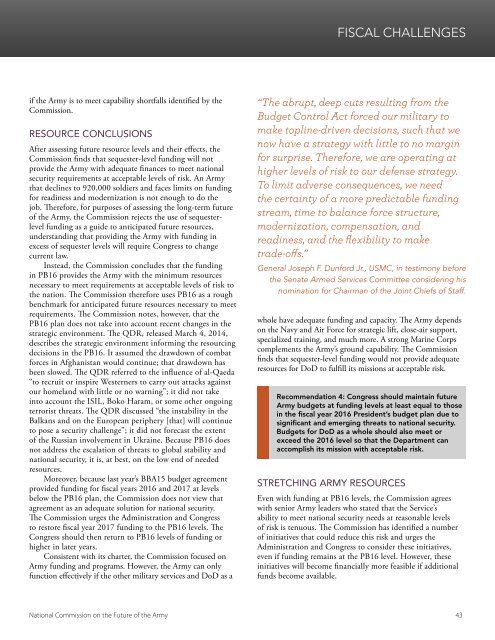THE FUTURE OF THE ARMY
Futurearmy
Futurearmy
You also want an ePaper? Increase the reach of your titles
YUMPU automatically turns print PDFs into web optimized ePapers that Google loves.
FISCAL CHALLENGES<br />
if the Army is to meet capability shortfalls identified by the<br />
Commission.<br />
RESOURCE CONCLUSIONS<br />
After assessing future resource levels and their effects, the<br />
Commission finds that sequester-level funding will not<br />
provide the Army with adequate finances to meet national<br />
security requirements at acceptable levels of risk. An Army<br />
that declines to 920,000 soldiers and faces limits on funding<br />
for readiness and modernization is not enough to do the<br />
job. Therefore, for purposes of assessing the long-term future<br />
of the Army, the Commission rejects the use of sequesterlevel<br />
funding as a guide to anticipated future resources,<br />
understanding that providing the Army with funding in<br />
excess of sequester levels will require Congress to change<br />
current law.<br />
Instead, the Commission concludes that the funding<br />
in PB16 provides the Army with the minimum resources<br />
necessary to meet requirements at acceptable levels of risk to<br />
the nation. The Commission therefore uses PB16 as a rough<br />
benchmark for anticipated future resources necessary to meet<br />
requirements. The Commission notes, however, that the<br />
PB16 plan does not take into account recent changes in the<br />
strategic environment. The QDR, released March 4, 2014,<br />
describes the strategic environment informing the resourcing<br />
decisions in the PB16. It assumed the drawdown of combat<br />
forces in Afghanistan would continue; that drawdown has<br />
been slowed. The QDR referred to the influence of al-Qaeda<br />
“to recruit or inspire Westerners to carry out attacks against<br />
our homeland with little or no warning”; it did not take<br />
into account the ISIL, Boko Haram, or some other ongoing<br />
terrorist threats. The QDR discussed “the instability in the<br />
Balkans and on the European periphery [that] will continue<br />
to pose a security challenge”; it did not forecast the extent<br />
of the Russian involvement in Ukraine. Because PB16 does<br />
not address the escalation of threats to global stability and<br />
national security, it is, at best, on the low end of needed<br />
resources.<br />
Moreover, because last year’s BBA15 budget agreement<br />
provided funding for fiscal years 2016 and 2017 at levels<br />
below the PB16 plan, the Commission does not view that<br />
agreement as an adequate solution for national security.<br />
The Commission urges the Administration and Congress<br />
to restore fiscal year 2017 funding to the PB16 levels. The<br />
Congress should then return to PB16 levels of funding or<br />
higher in later years.<br />
Consistent with its charter, the Commission focused on<br />
Army funding and programs. However, the Army can only<br />
function effectively if the other military services and DoD as a<br />
“The abrupt, deep cuts resulting from the<br />
Budget Control Act forced our military to<br />
make topline-driven decisions, such that we<br />
now have a strategy with little to no margin<br />
for surprise. Therefore, we are operating at<br />
higher levels of risk to our defense strategy.<br />
To limit adverse consequences, we need<br />
the certainty of a more predictable funding<br />
stream, time to balance force structure,<br />
modernization, compensation, and<br />
readiness, and the flexibility to make<br />
trade-offs.”<br />
General Joseph F. Dunford Jr., USMC, in testimony before<br />
the Senate Armed Services Committee considering his<br />
nomination for Chairman of the Joint Chiefs of Staff.<br />
whole have adequate funding and capacity. The Army depends<br />
on the Navy and Air Force for strategic lift, close-air support,<br />
specialized training, and much more. A strong Marine Corps<br />
complements the Army’s ground capability. The Commission<br />
finds that sequester-level funding would not provide adequate<br />
resources for DoD to fulfill its missions at acceptable risk.<br />
Recommendation 4: Congress should maintain future<br />
Army budgets at funding levels at least equal to those<br />
in the fiscal year 2016 President’s budget plan due to<br />
significant and emerging threats to national security.<br />
Budgets for DoD as a whole should also meet or<br />
exceed the 2016 level so that the Department can<br />
accomplish its mission with acceptable risk.<br />
STRETCHING <strong>ARMY</strong> RESOURCES<br />
Even with funding at PB16 levels, the Commission agrees<br />
with senior Army leaders who stated that the Service’s<br />
ability to meet national security needs at reasonable levels<br />
of risk is tenuous. The Commission has identified a number<br />
of initiatives that could reduce this risk and urges the<br />
Administration and Congress to consider these initiatives,<br />
even if funding remains at the PB16 level. However, these<br />
initiatives will become financially more feasible if additional<br />
funds become available.<br />
National Commission on the Future of the Army 43


